


 This is Part 2 of a look at three South American artists who transcended both the 60s Pop Art scene while also keeping their hand in the world of traditional commercial art, cartooning and animation. Click here to read Part 1.
This is Part 2 of a look at three South American artists who transcended both the 60s Pop Art scene while also keeping their hand in the world of traditional commercial art, cartooning and animation. Click here to read Part 1.
Daniel Melgarejo
Compared to Azaro, the cartoonist and designer Daniel Melgarejo (1946-1989) seems to come from (or at least move more comfortably in) the terrain of a commercial artist. But appearances can be deceiving.
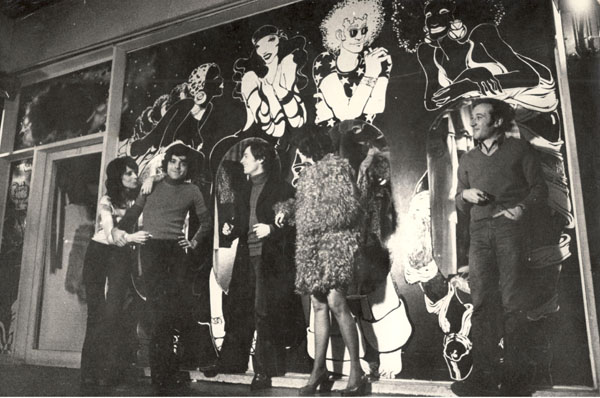
Showcase of Madame Frou-Frou, decorated by Melgarejo. Galería del Este, 1969. From left to right: Rosita Bailón, Dante Bertini, Marcial Berro, Isabel Uriburu and Daniel Melgarejo. Note: although other takes of the same scene identify Melgarejo as the last of the row, Jacoby does not believe it is him.
According to some reviews, Daniel also went through the experience of the avant-garde Di Tella Center in the late 60’s, but his friend and collaborator, the artist and theorist Roberto Jacoby, informs us that this connection was more indirect than is usually mentioned, since Melgarejo, who seems to have been exceptionally modest when it came to showing his work, exhibited very little, and he was mainly related with one of the Di Tella stars, the psychologist and philosopher Oscar Masotta (curator of the great Comic Biennial of 1968), with whom Melgarejo shared several common projects.
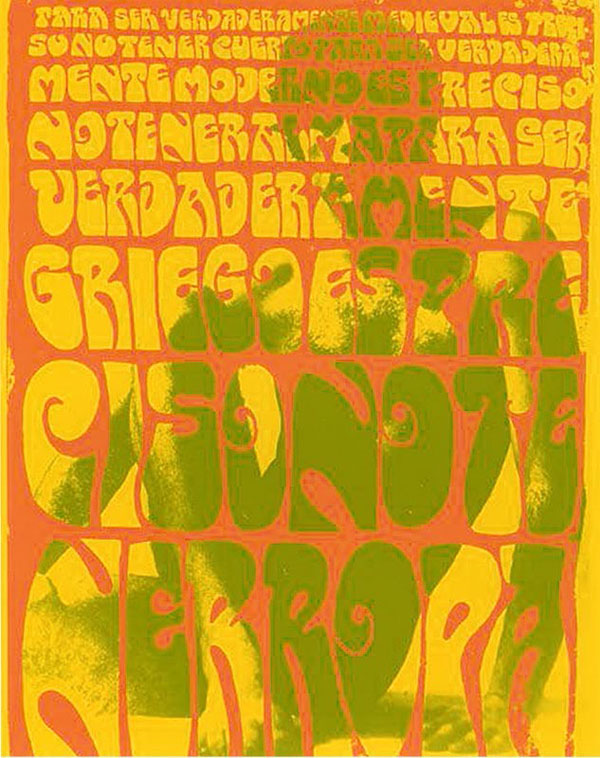
Poster made by Melgarejo and Jacoby for Jorge Álvarez, editor and Head of Mandioca Records.
Together with artist Hermenegildo Sábat, he was one of the few cartoonists of the Buenos Aires newspaper La Opinión (which was characterized by its cutting edge lack of photography) and devoted himself to the design of posters and album covers for the progressive Mandioca Records, for whom Daniel also created a logo. His work of those years (along with Juan Gatti’s, who would later be known as Pedro Almodóvar’s “official” poster artist) seems to have the influence of the US Undergrounds, and through them, the aesthetics of early comics. Retro before the retro.
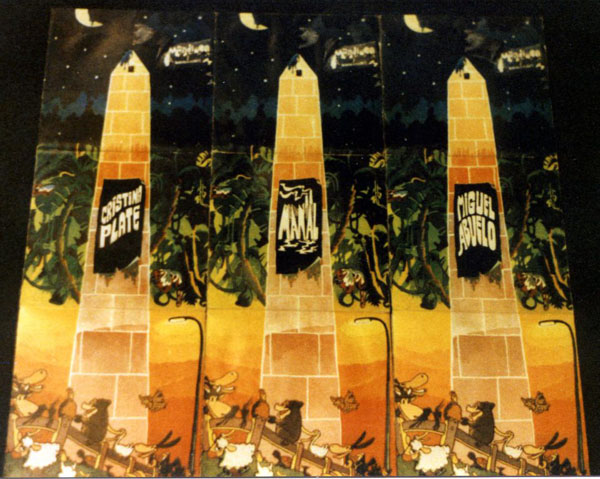
Gatefold album covers by Daniel Melgarejo (same layout, different artists) made for Mandioca, (1969).

Album cover of “Rock hasta que se ponga el sol” by Juan Gatti (1973).
Like Gatti, Melgarejo then moved to Barcelona around the mid 70’s, where he collaborated with the newspaper La Vanguardia and the local version of Playboy magazine.

Daniel Melgarejo’s drawings – above and below

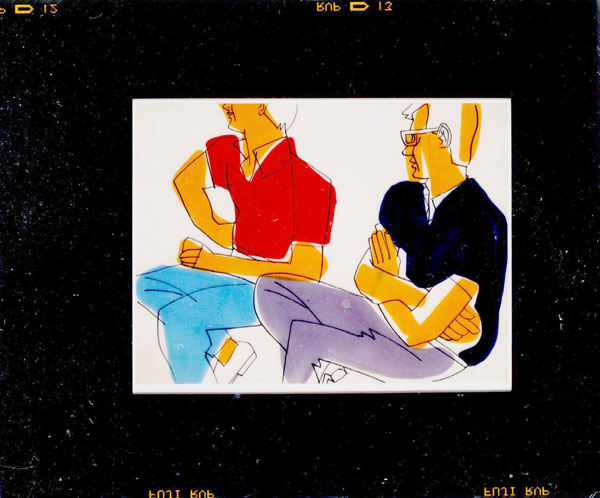
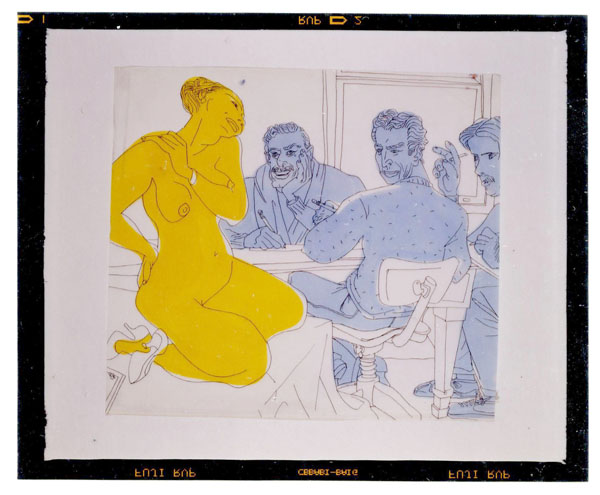
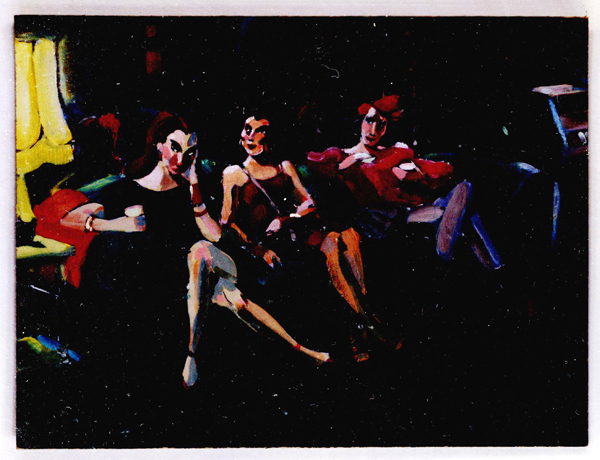
He returned to Buenos Aires around 1979, to leave again, this time for New York. It seems that there, Melgarejo went to 477 Madison Avenue, local headquarters of Walt Disney Productions, where he was hired on the spot in his way out to an elevator, after leaving his portfolio in some office. In Disney’s, Daniel worked mainly as a designer.
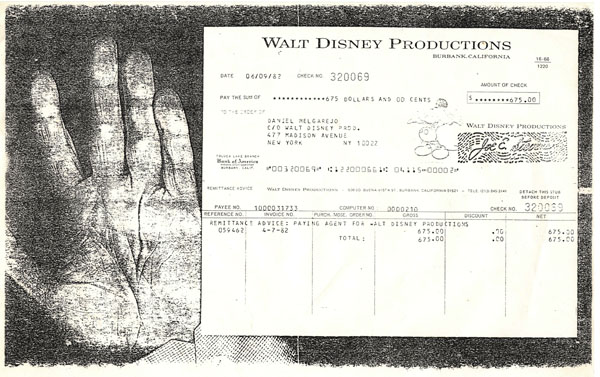
We presume that the hand is that of Melgarejo himself. Note: this image, as well as many others that illustrate this article, were generously provided to us by journalist Federico Lisica, who is producing a forthcoming book on the artist.
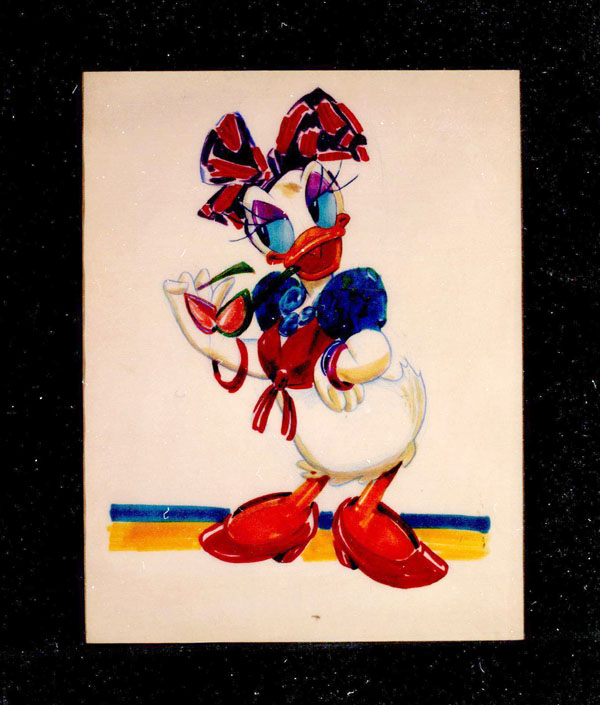
Above and below: some of Melgarejo’s Disney designs.
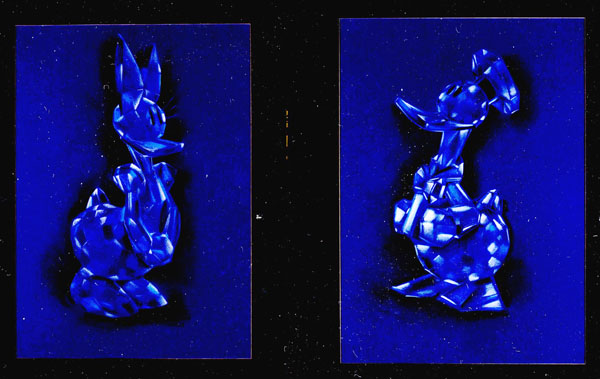
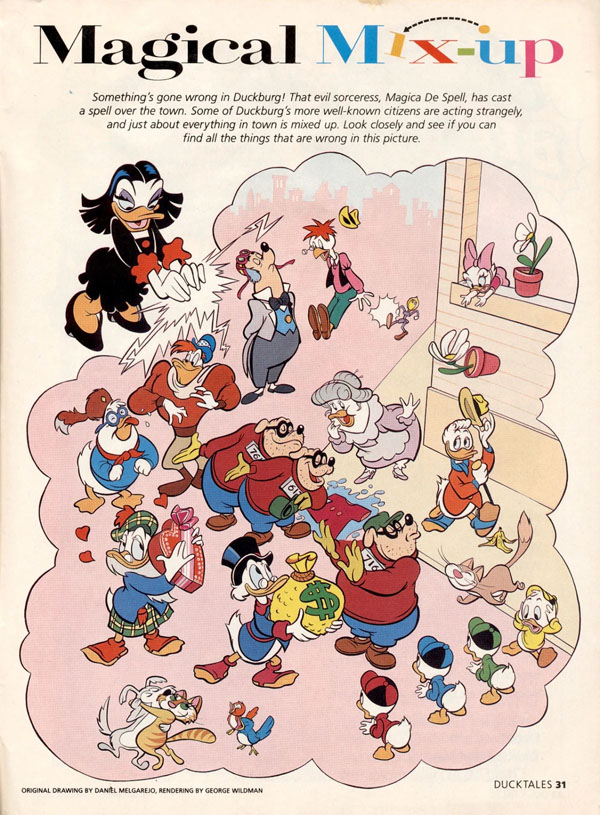
Melgarejo’s page for Disney.
Another source of information is -again- cartoonist Oscar Grillo, who wrote the following in his blog: “Daniel Melgarejo was a genius. I met him in our native Buenos Aires when he was twelve years old and I was a budding animator, we saw each other in Europe and I used to visit him in New York, where he died very young. Ours was a life time friendship. He was one of the most talented people I ever met. He could draw with both hands and often enough two different drawings at the same time. Everybody loved him and he made friends with people such as Marguerite Duras, Paloma Picasso, etc.”
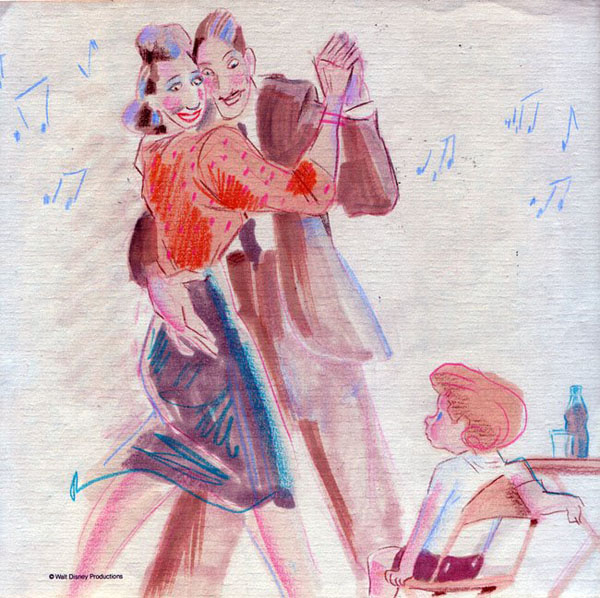
Since Grillo’s blog has numerous comments from people who knew Daniel and contribute their memories (too personal, in some cases, to transcribe here), we recommend a visit to it, through this link
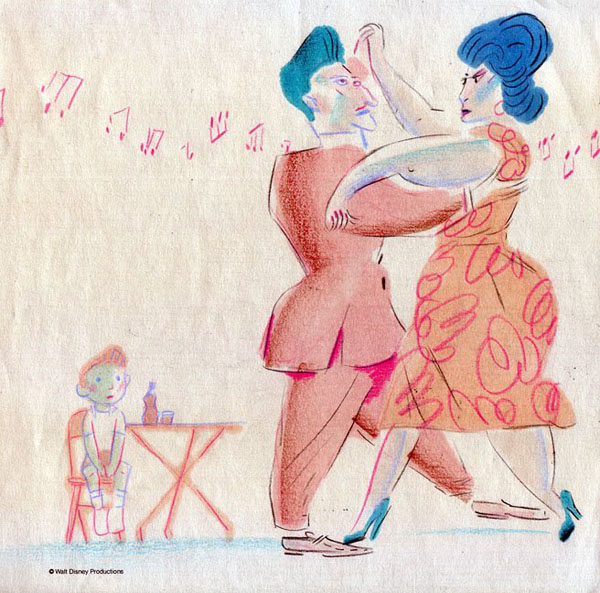
In parallel to his stay at Disney, Daniel was commissioned to design the characters for the animated short (directed by the animator Ric Machin) that opens the film Who’s That Girl? (1987), starring Madonna. According to the website “Art of Titles,” in an article published in 2017:
Director James Foley came up with the idea for an animated intro, Madonna wrote the song for it, and late Argentinian artist Daniel Melgarejo conceived the bobble-headed commotion-causing babe. “He did some sketches and just thought he caught the energy of Nikki Finn (Madonna’s character),” Foley says. “Love how his angular style matched the sonics of the song.”

To the same article, Ric Machin added:
The soundtrack had already been selected by Warner Brothers — Madonna’s “Causing a Commotion” — and an Argentinian artist, Daniel Melgarejo, had been drafted in to help with concept sketches and the general style of the piece. After a week or so, I had a catchy song and a pile of unconnected drawings and the brief to turn it into a three-minute animated sequence. Working with Daniel, we began to refine and simplify the characters and backgrounds and prepare them for animation.
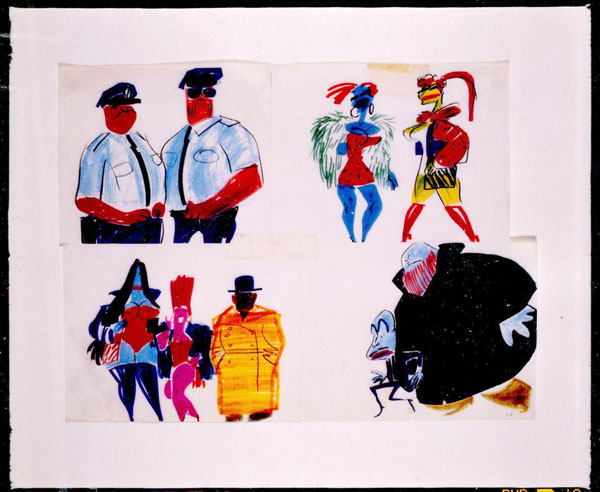
Melgarejo’s concept art – above and below
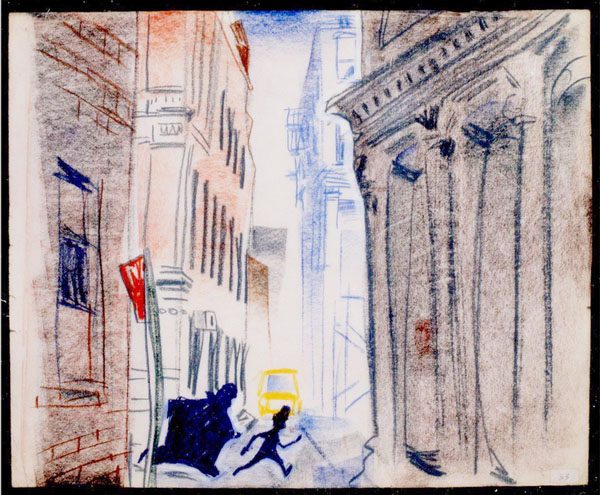
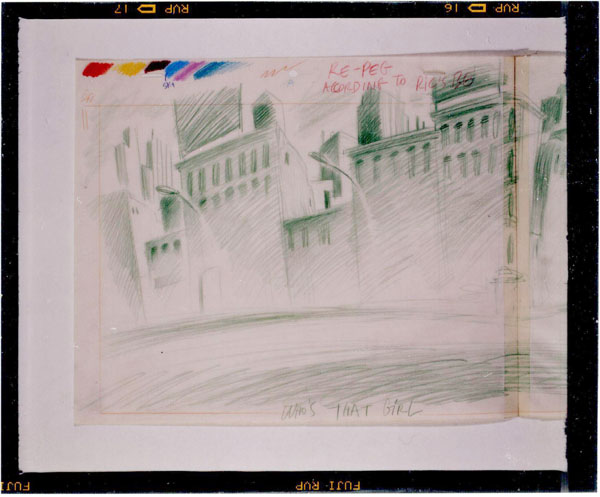
The final result can be seen at this link (as a curious aside, among the various animators of the sequence are listed Bill Plympton and John Canemaker):
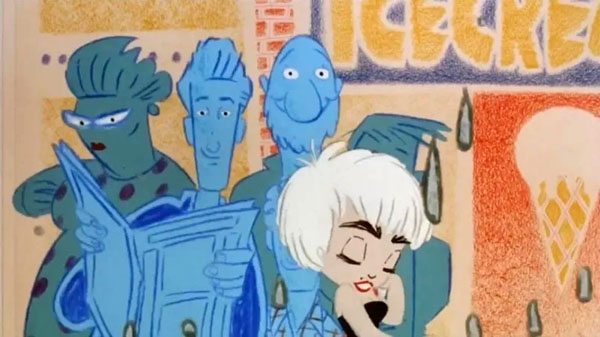
Likenesses of Ric Machin (center, with newspaper), Daniel Melgarejo (bald guy), and Neil Masterson (right, with mouse shirt) can be seen in these stills from the title sequence.
During those years, Daniel Melgarejo knew the popularity that scandal brings in his native Buenos Aires (although few knew his name) by illustrating the album covers of the Argentine pop band “Virus”.

His cover for Virus’ album “Locura” from 1985

Melgarejo’s cover for Virus’ album “Superficies de placer”, 1987. That’s the scandalous one, as you can guess. (Note: Jacoby brings the interesting fact that perhaps this cover was not really his work but that of the artist’s partner. It’s possible, since Daniel’s work is more organic and a little less “designy”)
Melgarejo was gay, like the singer of “Virus”, Federico Moura, whom he had known since the 70’s. Both died of AIDS a few months apart. Daniel Melgarejo passed away in New York in 1989.
By all accounts, he was more interested in the act of drawing than in the perpetuation of his signature or the preservation of his work, which he gave away to friends, admirers or the curious, making it extremely difficult to collect his work in any form of anthology or retrospective. His friend and colleague Roberto Jacoby helped a lot to a later appreciation of his work, more related (as in the case of Azaro) to the world of visual arts. The conservative vocation of this field has the usefulness of helping to preserve certain things.
Note: there are quite a few other “Daniel Melgarejo” on the web, including a contemporary Uruguayan artist. The author of this note would like to thank Roberto Jacoby and Federico Lisica for their special collaboration.

Patricio Bisso
Patricio Bisso (1957-2019) is our odd man out and I hesitated to put him in the company of Azaro and Melgarejo because he is better known as an actor and costume designer than as a cartoonist. However, the points in common with the others are several, and cartoons are not the least of them. It seems that Bisso discovered Melgarejo’s drawings in the newspaper La Opinión when he was fourteen years old and that determined his later career. In any case, Bisso came into contact with Melgarejo, seeking drawing lessons, and for a time he also drew in the same journal.
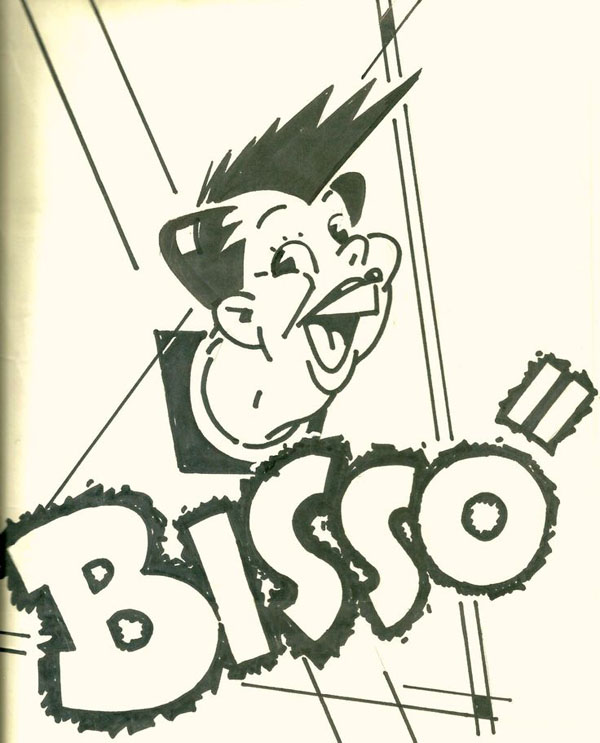
Caricature of the young Bisso, made by Melgarejo in 1980.
The following year, he dropped out of school and moved to São Paulo, Brazil, where he would spend most of his career (in fact, Bisso is a much better known artist in Brazil than in Argentina). He worked, while still a minor, as an illustrator for the DPZ advertising agency and Jornal da Tarde.
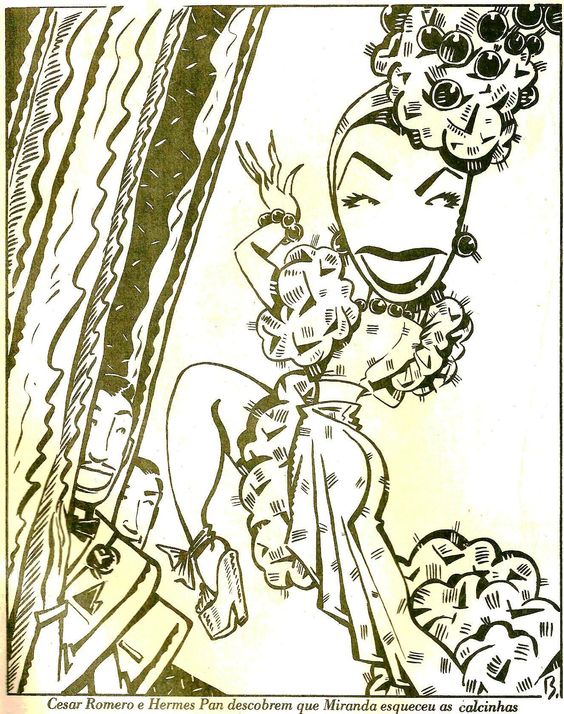
Above and below – some of the cartoons drawn by Bisso (mostly for the Brazilian press)
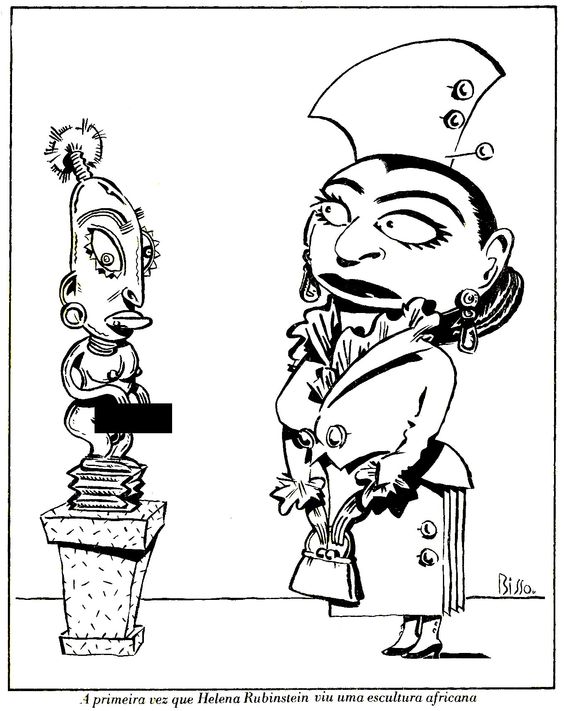

In 1974 he made his acting debut impersonating the Argentine actress and singer Libertad Lamarque in the play Ladies na Madrugada, de Mauro Rasi. His participation served to showcase the talent and versatility of Patricio, who, as well as acting, did his own costumes and make-up. Rasi’s play is considered a forerunner of the Besteirol, a Brazilian genre somewhat linked to experiences like Charles Ludlam’s Ridiculous Theatrical Company.
After spending time in London between 1978 and 1979, working at -you guessed it – Oscar Grillo’s animation studio, Patricio returned to São Paulo.
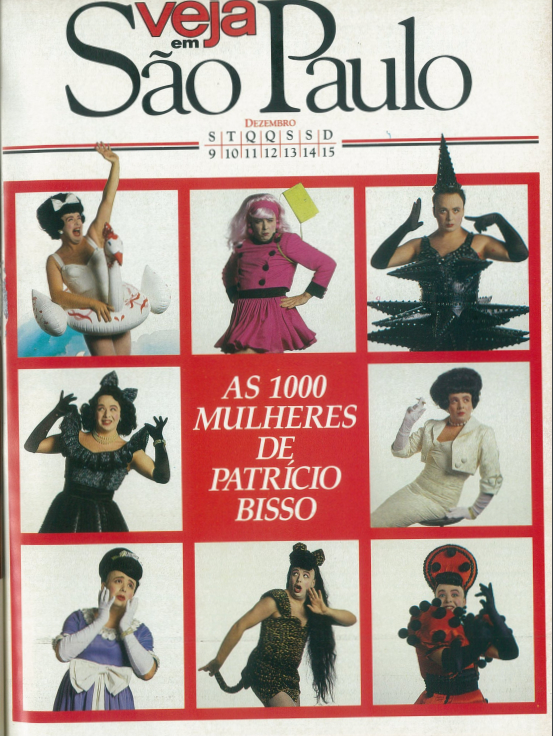
Cover of Veja magazine devoted to Bisso.
In the 1980s, he dedicated himself to creating a solo career as a performer in Brazil, alongside his career as a graphic artist and writer. From 1983 onwards, he had a fixed slot in the programming of Abril Video, a partnership between TV Gazeta and the Abril publishing house, in which he played the character that would forever mark his career: the Russian sexologist Olga del Volga.
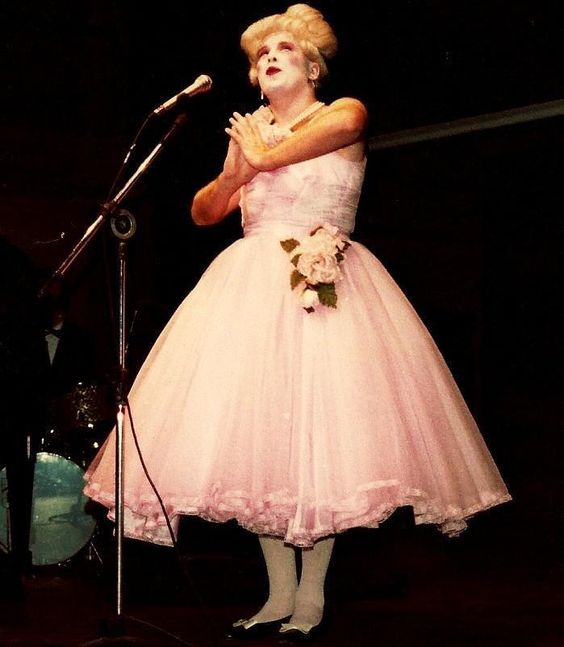
as Doris “Dias”.
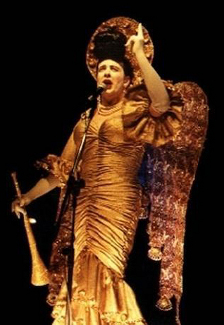
as Ethel Merman
During this decade, he also worked as an actor and costume designer for several films, including Héctor Babenco’s Kiss of the Spider Woman (1985), the first Brazilian feature to compete for the Oscars for best film and best director in 1986.

Bisso’s la soeur de la soeur sourrire
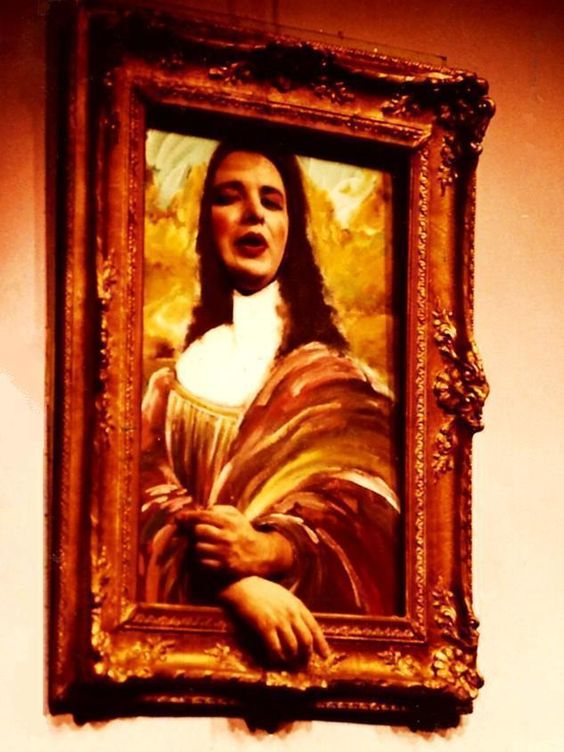
Bisso’s Nonna Lisa (1980).
In 1985, he brought to the stage one of his best-received shows, Louca Pelo Saxofone, in which he interpreted various divas of international song from the 1950s and 1960s. The show’s soundtrack became an album featuring Rita Lee and Wanderléa, among other successful artists.
Even though he didn’t pursue a career in his native Argentina, during the 1980s Bisso performed with rock groups from Buenos Aires like “Virus” or “Las Bay Biscuits”.
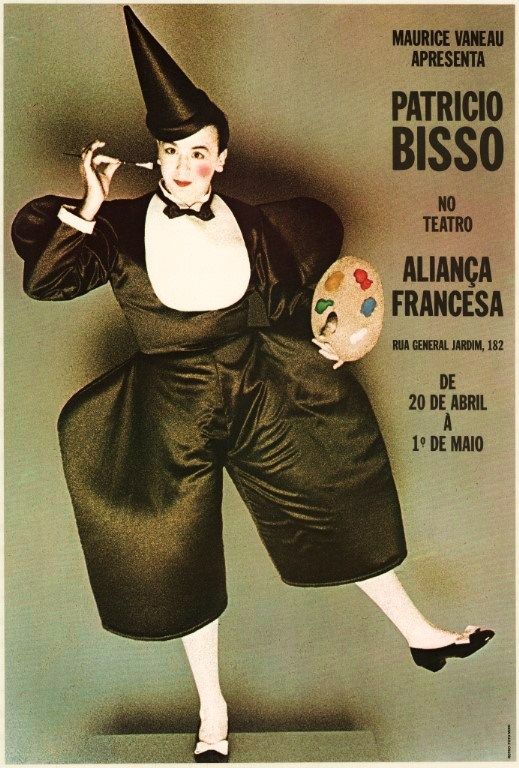
Bisso’s Poster
Bisso’s career as a cartoonist seems to have been secondary to his work on stage, of which unfortunately only a few videos and isolated appearances in films remain. And yet, Bisso’s graphic talents seem to have flourished especially in this area: his careful work in staging, costumes and make-up is cartoon in its purest form. Flesh-and-blood drawings that bring to mind the work of the more expressionistic (and German) Klaus Nomi, whom he nevertheless preceded by several years.
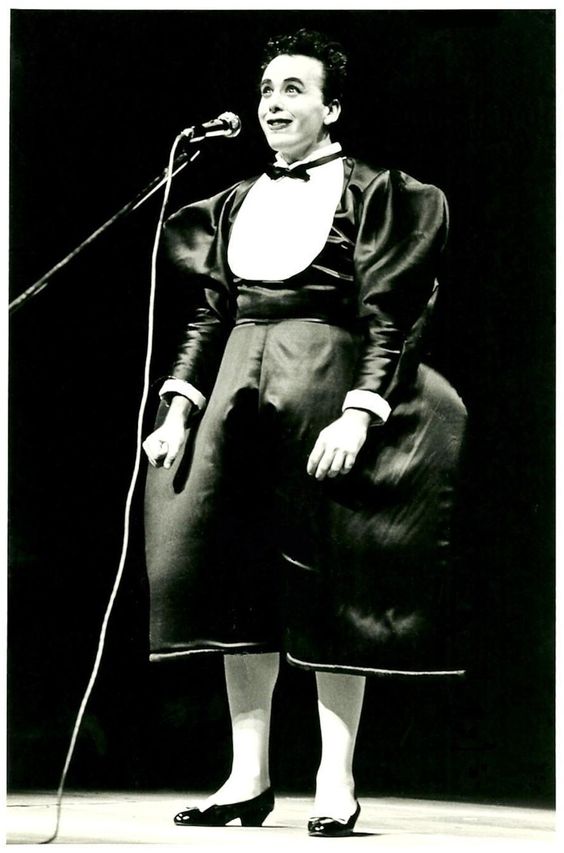
Bisso on stage.
Bisso never forgot his connections with graphic arts, and more precisely with animated cartoons. His last big show in Brazil was called Bissolandia.

“Bissolandia” poster, Bisso as Donald Duck
The Brazilian press wrote about it:
The theme now is the world of Walt Disney. Pinocchio, Cinderella, Peter Pan, Alice, Bambi, Mowgli, Mary Poppins and other characters, all embodied by Bisso, stage small scenes. “I evoked memorable moments from my childhood and chose the costumes and sets from memory.”

As Mary Poppins

as Cinderella
In all, there are 12 colorful panels that take the action to castles and enchanted forests. “I set the scene myself, guide the production and oversee the final product.” A conductor wearing Mickey ears leads an orchestra of 11 musicians. (…) Bisso researched Disney albums from his 1928 and 1967 productions. “In the 70s and 80s, Disney morals were a bit perverted, but Spielberg is restoring the old spirit.”

… as Bambi!
According to some sources, Bissolandia was withdrawn after a certain well-publicized media scandal that apparently also ended its author’s career on the Brazilian stage. After that, he continued to make illustrations for the press, as well as costumes for films, plays and musicals. In 2002, Patricio returned to Argentina.
In 2008, he wrote with filmmaker Bobby Houston the libretto for the musical Castronauts, or how I killed Fidel, which premiered on Broadway. Apparently, Castronauts didn’t click on with New York audiences and Bisso (one of the stars) was forced to abandon trunks full of costumes in the streets.
https://playbill.com/article/casting-announced-for-nymfs-castronauts-or-how-i-killed-fidel-com-152814
Image 67: Bisso with John Waters.
In his last years he retired to take care of his mother, in an almost reclusive life. He died in 2019 at his home in Buenos Aires. As in the preceding cases, his reflection in the press varies greatly, ranging from some retrospective review of his onstage work (much more frequent in Brazilian media) to the more predictable vindication in articles oriented to the LGBT+ audience.
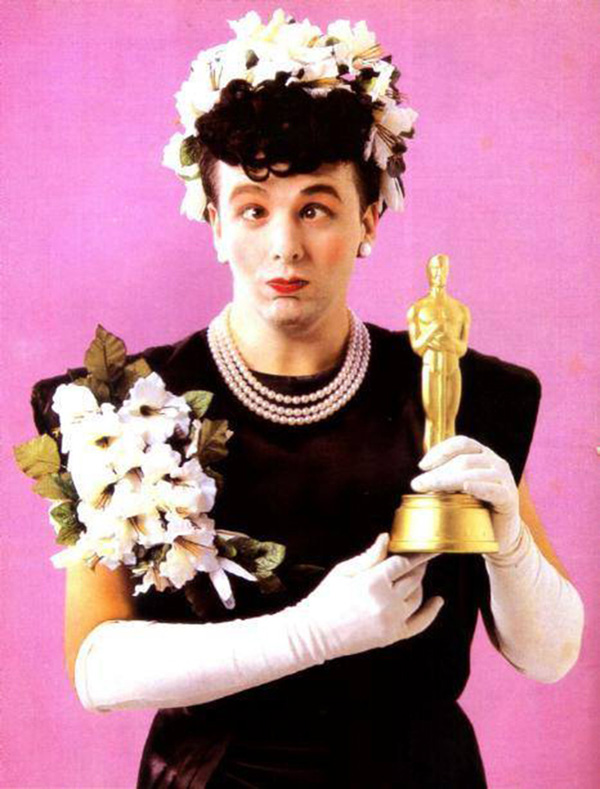
And so we conclude our brief three-part article on Azaro, Melgarejo and Bisso. Three geniuses in their own right, roaming through the world in strange and often unpredictable paths. Their differences are great and yet all three possess a common (perhaps melancholic) note that leads me to think of them as a group. Maybe it’s the accursed consciousness of being pop. Because…
From the moment the invaders arrived, breathed our air, ate and drank, they were doomed. They were undone, destroyed, after all of man’s weapons and devices had failed, by the tiniest creatures that God in his wisdom put upon this Earth: cartoons.